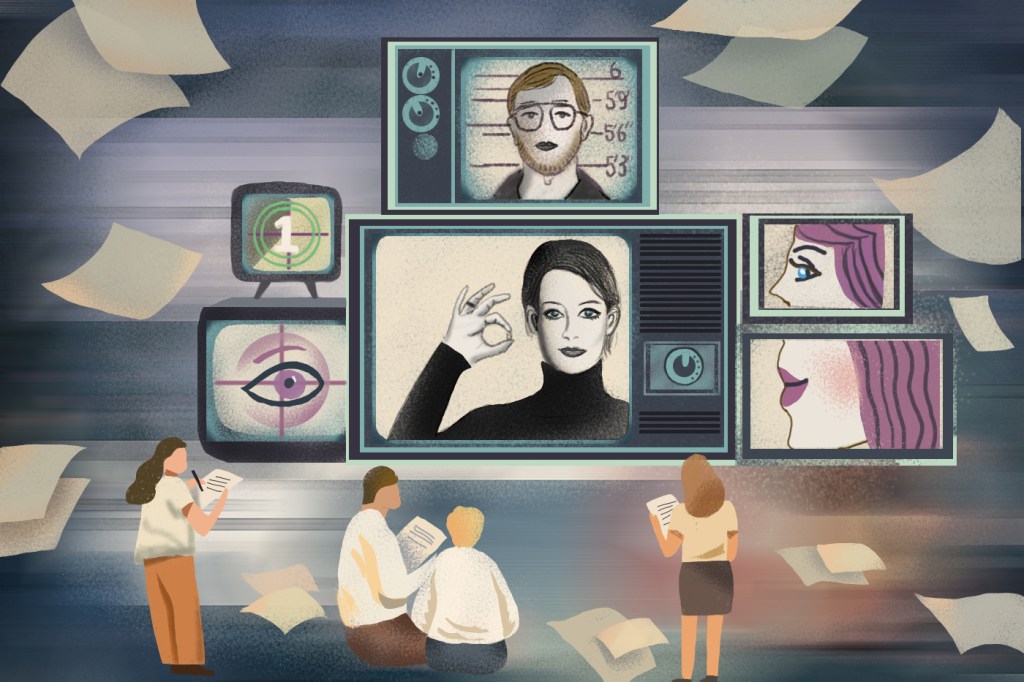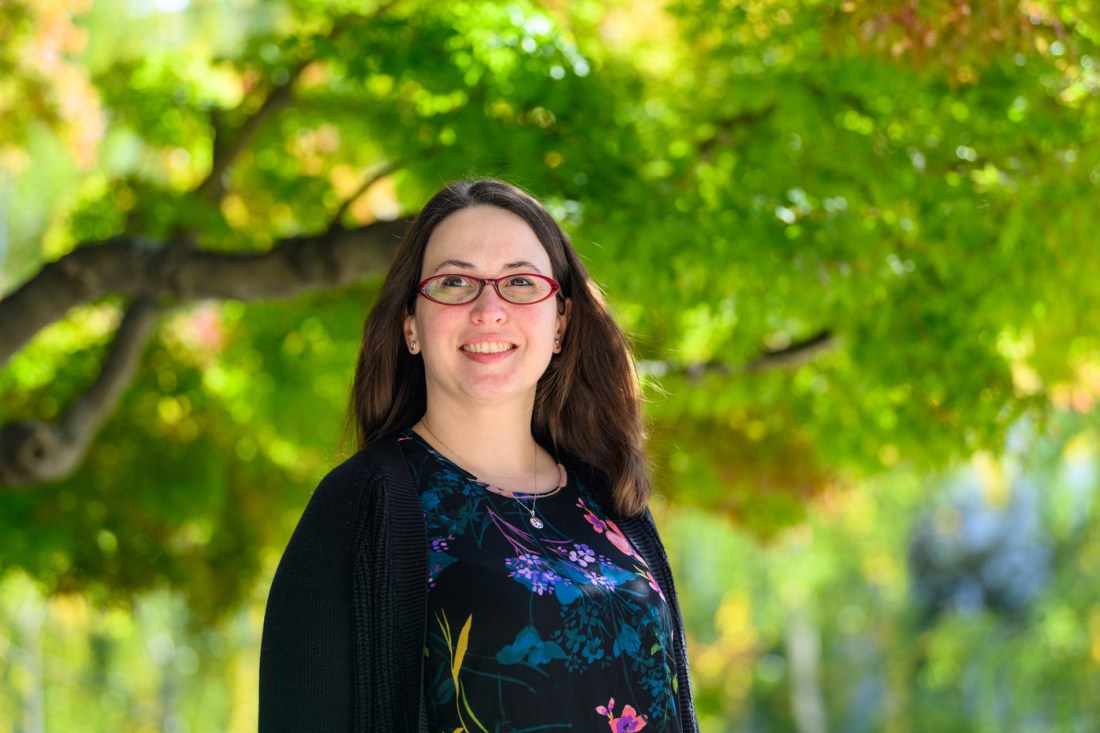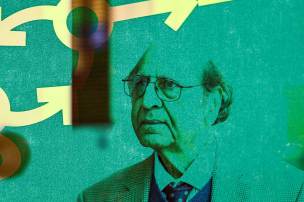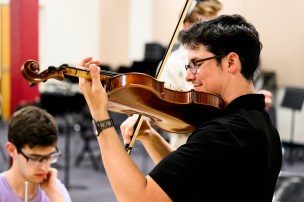Published on
We’re addicted to ‘true crime’ stories. This class investigates why
In MSCR 3920: True Crime Media, Laurel Ahnert takes students through a history of the genre — from 19th-century tabloids to Netflix — and unpacks our collective fascination with the darkest parts of human nature.

Elizabeth Holmes, the disgraced, now-jailed former founder of the medical devices startup Theranos, is ripe for case study across a range of academic fields. Biochemistry students can scrutinize the feasibility of Theranos’ claims that its blood-testing technology could perform a wide panel of tests with a finger prick. Law and business students can examine how Holmes defrauded investors and pushed the corporate ethos of Silicon Valley to a breaking point. Budding journalists can learn how she manipulated the media ecosystem, and how dogged investigative reporters finally pulled her claims apart.
In Laurel Ahnert’s class, the Elizabeth Holmes saga is yet something else: true crime.
Ahnert, a teaching professor in Communications Studies at Northeastern University, has devoted this session of MSCR 3920: True Crime Media (on April Fool’s Day, appropriately) to Holmes — examining her rise and fall alongside a syllabus milieu that includes serial killers Jeffrey Dahmer and Aileen Wornos, tabloid fascinations like Amanda Knox and streaming series fodder like Gypsy Rose Blanchard.

The 19 assembled students on the Boston campus are dissecting filmmaker Alex Gibney’s 2019 Holmes documentary “The Inventor,” teasing out the ways it relies on — and upends — common tropes in true crime narratives. On one hand, the film puts a heavy emphasis on Holmes’ looks, with lingering camera shots on her pale hair and ice-blue, unblinking eyes.
This is maddeningly par for the course in depictions of women who commit crimes, Anhert says. There’s an idea that “her appearance gives us insight into who she is,” she tells the class. “There seems to be two polarities: either she’s absolutely monstrous inside and out, and we can see it immediately. Or she’s treated as a trickster, because her appearance doesn’t match what we expect — ‘How could someone so attractive be so horrible?’”
On the other hand, Holmes’ misdeeds were corporate, and the film posits a more nuanced portrayal of her motives than a violent criminal might expect to receive, students point out. “It’s presented almost like a whoopsie,” says Amos Chapman, a third-year film and media studies major. “But it wasn’t a whoopsie. It was a deliberate thing. I think the documentary is trying to say she’s not as guilty: She thought she could do this, and then it didn’t happen.”
True Crime Media is a new offering in the College of Arts, Media and Design (CAMD) for the spring 2024 semester; when Anhert proposed the class last year, she knew interest would be strong. “Young people are really enthusiastic for true crime,” she says in an interview after the class meeting. “A shocking number of my students watch ‘Dateline.’”
That’s true beyond college campuses: In a 2022 YouGov poll, half of Americans surveyed said they enjoy true crime content, with 1 in 3 consuming it at least once a week. It’s the most popular podcast genre, particularly with women. Fodder is bottomless: The stories of Holmes, Blanchard, O.J. Simpson and scores of other gristly, well-known cases boast fictional and nonfiction multipart series on streaming platforms and podcast networks.
Young people are really enthusiastic for true crime. A shocking number of my students watch ‘Dateline.’
Laurel Ahnert, Communication Studies assistant teaching professor
“For the past few years, as the U.S. murder rate has approached historic lows, stories about murder have become culturally ascendant,” journalist Rachel Monroe writes in the 2019 book “Savage Appetites,” an assigned reading. “The crime-minded among us were inundated with content, whether our tastes tended toward high-end HBO documentaries interrogating the justice system or something more like Investigation Discovery’s Swamp Murders.”
Anhert saw an opportunity for further inquiry. True Crime Media includes lessons on storytelling technique, and the final project has students working in groups to create their own 10-minute podcasts. But the course also tackles broad questions of perception, truth and the ways we have been conditioned to tell — and understand — certain familiar narratives, from 19th-century tabloids to serialized podcasts and the latest viral Netflix documentary. “The class came out of [asking], how can we think about this in a more critical way?” Anhert says.
OId stories, new forms
Thanks to its prevalence in newer media formats, true crime can seem like a recent craze. But as the syllabus makes clear, public fascination with unspeakable deeds is nothing new. (Sherlock Holmes was a sensation in the Victorian era, after all). At the beginning of the semester, Ahnert and her students spent a day looking through police gazettes from the 1800s — pulpy broadsheets that recounted violent crime reports for public consumption and predecessors of the tabloid media that set the tone for most true crime reporting in the 20th century.
“It was really interesting reading those and seeing them evolve into magazines of the ’60s and ’70s,” says Daniel Heinrichs, a fourth-year economics and environmental studies major with a minor in film. By looking at that archival media, students see how far back many of the genre’s common character tropes — from the “ideal” victim (an attractive white woman, historically) to the depraved killer who seems “perfectly normal” — reach.
The course is also heavy on documentaries (Ahnert’s academic specialty), and podcasts, a major driver of the modern-day true crime boom starting with the smash hit “Serial” in 2014. The class has touched on how that formal conceit — a story drawn out over multiple episodes — has come to influence what we as consumers expect from the content.
“It’s funny the way our linguistics have evolved — a serial killer and a serial show — it’s almost like the way that we watch movies and TV shows is the way that these killings occur,” Heinrichs says.
It’s had real-world implications as well. A lot of true crime media — from wall-to-wall cable coverage of criminal trials to series like “Making a Murderer” — make the viewer feel like part of the action.
“We talk about the emergence of Court TV and viewers becoming armchair detectives,” Ahnert says. “[Shows] invite us to scrutinize the demeanor of witnesses or the accused, to look at evidence. They teach us about forensic science.”
She’s assigned readings from legal professionals about the “CSI” effect — named after the long-running TV drama franchise about crime scene investigators. “Juries are now coming in expecting a certain level of forensic evidence that historically hasn’t been the threshold for getting a conviction. These shows are shaping people’s perception of what’s possible to prove.”
‘Everyone’s ready to jump in’
In its first outing, True Crime Media has attracted students from all over the university. “It’s a real mix,” Ahnert says. “I have people who are just starting their second semester, and I have a couple of graduating seniors.” Along with film and media studies majors fulfilling degree requirements, there are business and biology students. “True crime is something they enjoy, and they want to learn more about it. It’s not necessarily because they see it as a clear part of their major.”
Heinrichs says that organic enthusiasm — from both the students and Ahnert herself — has made the class a highlight of his Northeastern experience. “Everyone’s ready to jump into conversation,” he says. “Everyone comes to class having read the readings and watched the documentaries.”
“You can tell that [Anhert] loves this stuff,” he adds. “It’s almost like a recommendation from a friend when we’re watching a movie or listening to a podcast.”
Heinrichs says he’s also gotten useful lessons beyond the explicit (pun intended) subject matter, both for his own educational trajectory and for navigating today’s informational landscape. He’s been using his econ background to think about true crime as an economic industry, and the ways in which it exploits the hardships of others and often becomes a potential, vital income source for its most high-profile subjects. For example, he points out, Gypsy Rose Blanchard was released from prison this year after serving time for murdering her abusive mother. Now, having made no money off adaptations of her story, she’s trying to get by as a TikTok star. True Crime Media helped illuminate those dynamics.
“It’s an awesome class. I wouldn’t be talking to you if it wasn’t,” he says.
Schuyler Velasco is a Northeastern Global News Magazine senior writer. Email her at s.velasco@northeastern.edu. Follow her on X/Twitter @Schuyler_V.










